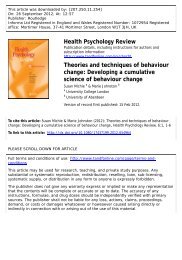The 5A's An Evidence-Based Assessment & Intervention Model
The 5A's An Evidence-Based Assessment & Intervention Model
The 5A's An Evidence-Based Assessment & Intervention Model
Create successful ePaper yourself
Turn your PDF publications into a flip-book with our unique Google optimized e-Paper software.
<strong>The</strong> 5A’s: <strong>An</strong> <strong>Evidence</strong>-<strong>Based</strong><br />
<strong>Assessment</strong> & <strong>Intervention</strong> <strong>Model</strong><br />
Christopher L. Hunter, Ph.D., ABPP<br />
DoD Program Manager<br />
for Behavioral Health in Primary Care<br />
<strong>The</strong> views expressed in this presentation are those of the presenter and do not<br />
necessarily reflect the official policy or position of the Department of Defense (DoD),<br />
the Public Health Service, or the U.S. Government.<br />
1
5A’s-Assess, Advise, Agree, Assist, Arrange<br />
Goals<br />
1. Use 5A’s as an Operational Heuristic<br />
Assess Advise Agree Assist Arrange<br />
2. Walk Away with Tools You Can Immediately Use<br />
2
Arrange<br />
Specify plans for<br />
follow-up<br />
(visits, phone calls,<br />
mail reminders)<br />
5A’s-Assess, Advise, Agree, Assist, Arrange<br />
Diagram adapted from: Glasgow, R. E & Nutting, P. A. (2004). Diabetes. In Handbook of<br />
Primary Care Psychology. Ed., Hass, L. J. (pp. 299-311)<br />
Assess<br />
Risk Factors, Behaviors, Symptoms,<br />
Attitudes, Preferences<br />
Personal Action Plan<br />
1. List goals in behavioral terms<br />
2. List strategies to change health behaviors<br />
3. Specify follow-up plan<br />
4. Share plan with practice team<br />
Advise<br />
Specific, personalized,<br />
options for tx, how sx<br />
can be decreased,<br />
functioning, quality of<br />
life/health improved<br />
Assist<br />
Provide information, teach<br />
skills, problem solve<br />
barriers to reach goals<br />
Agree<br />
Collaboratively select goals<br />
based on patient interest and<br />
motivation to change<br />
3
Phases of a 30-Minute Appointment<br />
1. Introduction of behavioral health consultation service (1-2 minutes)<br />
2. Identifying/Clarifying consultation problem (10-60 seconds) Assess<br />
3. Conducting functional analysis of the problem (12-15 minutes)<br />
4. Summarizing your understanding of the problem (1-2 minutes)<br />
5. Listing out possible change plan options (selling it) (1-2 minutes) Advise<br />
Agree<br />
6. Starting a behavioral change plan (5-10 minutes) Assist<br />
Arrange
5A’s-Assess, Advise, Agree, Assist, Arrange<br />
-Functional <strong>Assessment</strong><br />
-Biopsychosocial <strong>Model</strong><br />
-Physical<br />
-Behavioral<br />
-Cognitive<br />
-Emotional<br />
-Environmental factors<br />
Assess
5A’s-Assess, Advise, Agree, Assist, Arrange<br />
Advise<br />
-Give clear, specific, & personalized change advice<br />
-What changes will be involved & how it might be beneficial
5A’s-Assess, Advise, Agree, Assist, Arrange<br />
Agree<br />
Collaboratively select goals-pt’s interest & willingness to change<br />
-Find common ground & define behavior change goals & methods<br />
-Shared decision making = Greater sense of personal control<br />
Choices based on realistic expectations<br />
Change matches patient values
5A’s-Assess, Advise, Agree, Assist, Arrange<br />
Assist<br />
-Develop a specific tailored action plan<br />
-Plan should:<br />
1. Help identify, address and overcome barriers<br />
2. Develop self-management skills<br />
3. Develop confidence to successfully change
5A’s-Assess, Advise, Agree, Assist, Arrange<br />
Arrange<br />
-Specific plans for subsequent contacts<br />
-Individual, Group<br />
-Other providers/adjunctive treatment
5A’s-Assess, Advise, Agree, Assist, Arrange<br />
Diagram adapted from: Glasgow, R. E & Nutting, P. A. (2004). Diabetes. In Handbook of<br />
Primary Care Psychology. Ed., Hass, L. J. (pp. 299-311)<br />
Assess<br />
Risk Factors, Behaviors, Symptoms,<br />
Attitudes, Preferences<br />
Arrange<br />
Specify plans for<br />
follow-up<br />
(visits, phone calls,<br />
mail reminders)<br />
Personal Action Plan<br />
1. List goals in behavioral terms<br />
2. List strategies to change health behaviors<br />
3. Specify follow-up plan<br />
4. Share plan with practice team<br />
Advise<br />
Specific, personalized,<br />
options for tx, how sx<br />
can be decreased,<br />
functioning, quality of<br />
life/health improved<br />
Assist<br />
Provide information, teach<br />
skills, problem solve<br />
barriers to reach goals<br />
Agree<br />
Collaboratively select goals<br />
based on patient interest and<br />
motivation to change<br />
10
5A’s-Assess, Advise, Agree, Assist, Arrange<br />
11

















